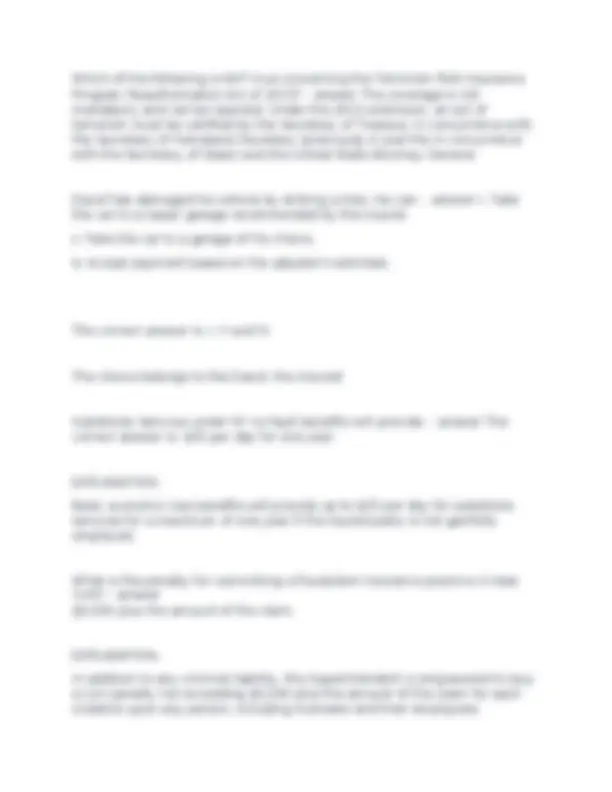






Study with the several resources on Docsity

Earn points by helping other students or get them with a premium plan


Prepare for your exams
Study with the several resources on Docsity

Earn points to download
Earn points by helping other students or get them with a premium plan
Community
Ask the community for help and clear up your study doubts
Discover the best universities in your country according to Docsity users
Free resources
Download our free guides on studying techniques, anxiety management strategies, and thesis advice from Docsity tutors
A study guide for the new york auto exam 17-66, containing 100% correct answers to various questions related to auto insurance, fraud, waivers, inspections, coverage, and more. It is a valuable resource for anyone preparing for the new york auto insurance exam.
Typology: Exams
1 / 8

This page cannot be seen from the preview
Don't miss anything!





All of the following are reasons that an adjuster should keep very detailed log notes, EXCEPT: - answer to produce notes that will support a fraudulent denial of claims. The adjuster's log notes are used to determine negligent parties, to assist in detecting fraud, to become a part of the claims file, and to be used in future proceedings. The log notes are not intended to produce a fraudulent record to deny a claim. When a homeowner’s policy has been in effect for 60 days in New York, an insurer can cancel at any time for any of the following reasons, EXCEPT: - answer A large loss has occurred George Wilson has a personal auto policy. Select the coverage that would apply when a deer leaps onto Mr. Wilson's car and causes extensive damage.
its representative knowingly gives up a known right under the insurance contract. Perhaps the right to request an
Which of the following is NOT true concerning the Terrorism Risk Insurance Program Reauthorization Act of 2015? - answer The coverage is not mandatory and can be rejected. Under the 2015 extension, an act of terrorism must be certified by the Secretary of Treasury in concurrence with the Secretary of Homeland Secretary (previously it was the in concurrence with the Secretary of State) and the United State Attorney General. David has damaged his vehicle by striking a tree. He can: - answer I. Take the car to a repair garage recommended by the insurer. II. Take the car to a garage of his choice. III. Accept payment based on the adjuster's estimate. The correct answer is: I, II and III. The choice belongs to the David, the insured Substitute Services under NY no fault benefits will provide: - answer The correct answer is: $25 per day for one year. EXPLANATION: Basic economic loss benefits will provide up to $25 per day for substitute services for a maximum of one year if the injured party is not gainfully employed. What is the penalty for committing a fraudulent insurance practice in New York? - answer $5,000 plus the amount of the claim. EXPLANATION: In addition to any criminal liability, the Superintendent is empowered to levy a civil penalty not exceeding $5,000 plus the amount of the claim for each violation upon any person, including licensees and their employees.
An insurance professional that is accused of dishonesty or breach of trust involving interstate commerce under Title 18 Section 1033 of the United State Code, will be prosecuted by: - answer The U.S. Attorney general. EXPLANATION: This breach of trust or dishonesty involving interstate commerce is a violation of USC 1033 and therefore prosecuted by the United States Attorney General's office. Under the commercial auto policy providing physical damage, which of the following offers the broadest coverage? - answer Comprehensive. EXPLANATION: Comprehensive coverage would be the broadest because it covers anything that is not defined as collision. The specified cause of loss is a named peril form and thus, is more limited. Driver 1 and Driver 2 are in an accident. Driver 2 has the following damages: Property Damage - $1,000 Rental Car Expense - $ Emergency Room Expense
Replacement cost coverage is best defined as: - answer Replacement without deduction for depreciation. is correct. EXPLANATION: With replacement cost coverage, the insured is permitted to replace old with new at today's cost without a deduction for depreciation. No insurer may issue checks or drafts or partial settlement of a loss or claim that is still being negotiated that: - answer Releases the insurer from additional liability. EXPLANATION: An insurer cannot issue a check for partial payment of a claim that contains language that releases the insurer from total liability unless the limit of the policy or the bond has been paid or a compromise has been otherwise made. Insurers conducting business in New York must be examined at least once every: - answer 5 years. is correct. EXPLANATION: Each insurer conducting business in New York must be examined in detail at least once every five years. Any company under investigation is responsible for all expenses involved in the examination. Coach Joe loans his car, covered under a personal auto policy, to assistant coach Tom to take several members of the Lake Recreation Swim Team home after a meet. In the event of an accident, the liability section of the personal auto policy would cover all of the following, EXCEPT: - answer The auto manufacturer. EXPLANATION:
Coach Joe is covered because he owns the car. Assistant coach Tom is covered because he had Joe's permission to drive his car. Lake Recreation Swim Team is also an insured but only with respect to legal responsibilities for acts or omissions of a person for whom coverage is afforded.